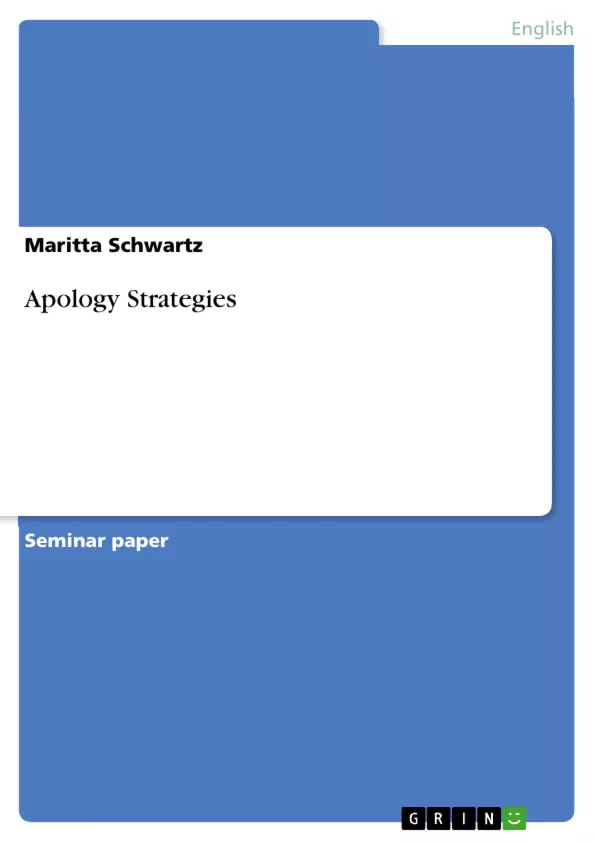Introduction
In this paper we are going to deal with different theories concerning apology strategies. As there exists a variety of different theories, I chose just three of them for this paper. I will introduce their concepts, compare their differences
and try to give a final evaluation of the three concepts.
Blum-Kulka/Olshtain1
I will begin with the model of Shoshana Blum–Kulka and Elite Olshtain.
They first of all classify apology as a speech act, name preconditions that are inevitable for an apology to take place and then list different strategy types.
Apologie als a speech act: classification
The apology belongs to the post-event-acts, i.e. it signals that a certain type of event has already taken place. Moreover, the speaker recognizes the fact that a violation of a social norm has been committed and that the speaker is at least partially involved in its cause. The involvement means a loss of face (= face threatening) for the speaker and is hearer-supportive.2
1 Blum-Kulka, S., Olshtain, E.; “Requests and Apologies: A Cross-Cultural Study of Speech Act Realization Patterns”
in: Applied Linguistics, 5 / 1984. (p. 196-213)
2 ebenda, p. 206
Inhaltsverzeichnis (Table of Contents)
- Introduction
- Blum - Kulka / Olshtain
- Apology as a speech act: classification
- Preconditions for an apology to take place.
- Apology strategies.
- Coding of an apology
- Subcategories of the IFID
- Subcategories of Taking on Responsibility.
- Explanation, offer of repair, promise of forbearance.
- Apology intensification...
- Factors for the choice of a specific apology intensity.
- Bruce Fraser
- Apology as a speech act: classification
- Apology: What do we believe to be true about the speaker?
- Preconditions for an apology.
- Apology strategies.
- Factors influencing the choice of an apology strategy
- Anna Trosborg..
- Apology: classification as a speech act
- Factors influencing the choice of an apology..
- Apology categories......
- Complainee does not take on responsibility.
- Minimizing the degree of offence.
- Acknowledgement of responsibility
- Explanation or account
- Expression of apology..
- Offer of repair.
- Promise of forbearance
- Expressing concern for hearer…..\n
- Comparison and evaluation of the three models.
- Classification as a speech act.
- Preconditions for an apology..
- Apology strategies .
- Apology intensification
- Factors influencing the choice of apology.
- Evaluation of the three models
- Bibliography ..
Zielsetzung und Themenschwerpunkte (Objectives and Key Themes)
This paper aims to analyze and compare different theoretical approaches to apology strategies. It delves into three prominent models, highlighting their core concepts, differences, and overall contributions to understanding apology in language.
- The classification of apology as a speech act within the context of social norms and face-threatening behavior.
- The preconditions that necessitate an apology, including the speaker's awareness of the offense and the impact on the hearer.
- The various apology strategies employed, ranging from explicit statements of regret to indirect expressions of responsibility and repair.
- The factors that influence the choice of a specific apology strategy, taking into account cultural context, power dynamics, and the severity of the offense.
- The comparison and evaluation of the three models, highlighting their strengths and weaknesses in explaining apology behavior.
Zusammenfassung der Kapitel (Chapter Summaries)
- The introductory chapter sets the stage for the paper by outlining its focus on apology strategies and the three models chosen for analysis.
- The second chapter explores the model of Blum-Kulka and Olshtain, which classifies apology as a post-event act, identifies preconditions for its occurrence, and outlines various strategy types. These strategies include the explicit illocutionary force indicating device (IFID) and indirect expressions involving responsibility, repair, and forbearance.
- The third chapter focuses on the model of Bruce Fraser, which examines apology as a speech act, explores the speaker's intention and belief, and outlines preconditions for an apology. It also delves into the factors that influence the choice of an apology strategy, emphasizing the speaker's perception of the situation and their relationship with the hearer.
- The fourth chapter examines the model of Anna Trosborg, which categorizes apology as a speech act, explores the factors influencing apology choice, and presents a comprehensive framework for understanding apology categories. This framework includes various strategies ranging from denying responsibility to offering repair and expressing concern for the hearer.
- The fifth chapter provides a comparative analysis of the three models, highlighting their similarities and differences in terms of classification, preconditions, strategies, intensification, and the factors influencing apology choice.
Schlüsselwörter (Keywords)
This paper centers around the key concepts of apology, speech acts, social norms, face-threatening behavior, apology strategies, preconditions, intensification, and cultural factors. It also touches on the perspectives of prominent researchers in the field, including Blum-Kulka and Olshtain, Bruce Fraser, and Anna Trosborg.
- Arbeit zitieren
- Maritta Schwartz (Autor:in), 1999, Apology Strategies, München, GRIN Verlag, https://www.grin.com/document/5107



